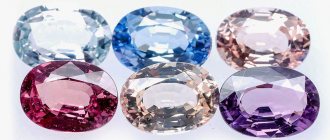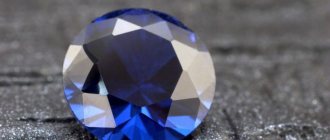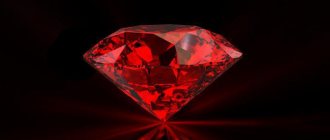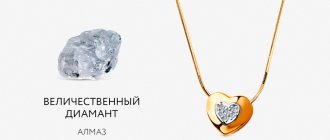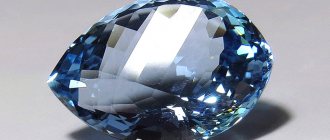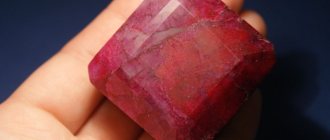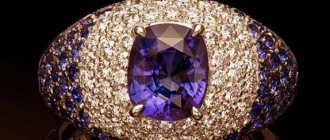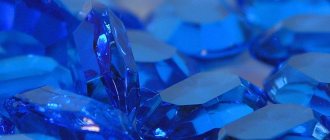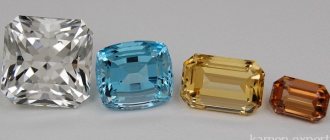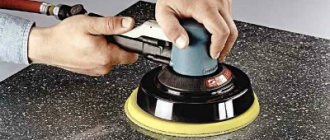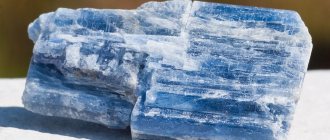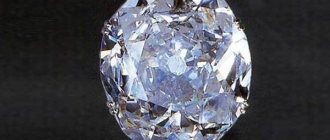Sapphire
- one of the varieties of the mineral corundum, a gemstone of different shades, mainly blue. In mineralogy, sapphires are exclusively blue corundums; in the jewelry industry, they are any colors except lilac-red (such stones are called rubies). The blue color of sapphire is caused by the presence of impurities of titanium (Ti) and iron (Fe). In the old days in Russia, sapphire, like other valuable blue minerals, was called baus. In technology, the name sapphire (leucosapphire) is often understood as colorless synthetic corundum single crystals containing 0.0001% impurities.
- Structure
- Properties
- Morphology
- Origin
- Application
- Classification
- Physical properties
- Optical properties
- Crystallographic properties
See also:
Sapphire
– price and medicinal, magical properties
Physical properties and structure of diamond
Physical and chemical properties
Sapphire is a hard corundum second only to diamond. The classic variety has a blue color, which appears due to impurities of iron and titanium in aluminum oxide. The presence of other impurities gives different shades. The stone can be either transparent or opaque. It has a high melting point (2040 degrees), does not solder and does not conduct electric current.
| Formula | Al2O3 |
| Color | The color range is varied, the most common is blue stone, there are also white, yellow, orange, pink, black, blue, gray and purple. May exhibit an asterism effect. |
| Shine | Strong glass, mother of pearl |
| Transparency | Various - from transparent to opaque |
| Dispersion | 0,18 |
| Hardness | 9 |
| Cleavage | absent |
| Kink | Uneven, conchoidal |
| Density | 3.93-4.00 g/cm³ |
| Melting temperature | 2040 degrees |
| Molecular weight | 101,96 |
| Specific gravity | 3,98-4,10 |
| singonia | Trigonal |
| Refractive index | 1,762-1,778 |
If sapphire is heated, it becomes colorless. But exposing the stone to X-rays, on the contrary, will make its color brighter and more saturated.
Problems for independent solution.
Part 1. Determination of the formula of a substance by composition.
1–1.
The density of hydrocarbons under normal conditions is 1.964 g/l. The mass fraction of carbon in it is 81.82%. Derive the molecular formula of this hydrocarbon.
1–2.
The mass fraction of carbon in the diamine is 48.65%, the mass fraction of nitrogen is 37.84%. Derive the molecular formula of diamine.
1–3.
The relative vapor density of saturated dibasic carboxylic acid in air is 4.07. Derive the molecular formula of a carboxylic acid.
1–4.
2 liters of alkadiene at no. has a mass of 4.82 g. Derive the molecular formula of alkadiene.
1–5. (Unified State Exam 2011)
Establish the formula for a saturated monobasic carboxylic acid, the calcium salt of which contains 30.77% calcium.
Part 2. Determination of the formula of a substance based on combustion products.
2–1.
The relative vapor density of an organic compound for sulfur dioxide is 2. When 19.2 g of this substance is burned, 52.8 g of carbon dioxide (n.s.) and 21.6 g of water are formed. Derive the molecular formula of an organic compound.
2–2.
When burning organic matter weighing 1.78 g in excess oxygen, 0.28 g of nitrogen, 1.344 l (n.s.) CO2 and 1.26 g of water were obtained. Determine the molecular formula of the substance, knowing that the indicated sample of the substance contains 1.204•1022 molecules.
2–3.
Carbon dioxide obtained by burning 3.4 g of hydrocarbon was passed through an excess of calcium hydroxide solution to obtain 25 g of sediment. Derive the simplest formula for a hydrocarbon.
2–4.
During the combustion of organic matter containing C, H and chlorine, 6.72 liters (n.s.) of carbon dioxide, 5.4 g of water, and 3.65 g of hydrogen chloride were released. Determine the molecular formula of the burnt substance.
2–5. (Unified State Exam 2011)
When the amine burned, 0.448 l (n.s.) of carbon dioxide, 0.495 g of water and 0.056 l of nitrogen were released. Determine the molecular formula of this amine.
Part 3. Determining the formula of a substance based on its chemical properties.
3–1.
Determine the formula of an alkene if it is known that 5.6 g of it, when added with water, form 7.4 g of alcohol.
3–2.
To oxidize 2.9 g of saturated aldehyde to acid, 9.8 g of copper (II) hydroxide was required. Determine the formula of the aldehyde.
3–3.
A monobasic monoamino acid weighing 3 g with an excess of hydrogen bromide forms 6.24 g of salt. Determine the amino acid formula.
3–4.
When a saturated diatomic alcohol weighing 2.7 g interacted with excess potassium, 0.672 liters of hydrogen were released. Determine the formula of alcohol.
3–5. (Unified State Exam 2011)
The oxidation of saturated monohydric alcohol with copper (II) oxide yielded 9.73 g of aldehyde, 8.65 g of copper and water. Determine the molecular formula of this alcohol.
Colors and varieties of sapphire
When talking about sapphire, they traditionally mean a blue stone - this is the most common type. But in nature there are several varieties of corundum, which jewelers also classify as sapphires, classifying them in a separate group “fancy”. They are divided by color, special properties, deposit and other characteristics.
Blue sapphire
A cornflower blue stone is considered ideal, but such representatives are few and are highly valued. More often, stones are darker or lighter blue in color with gray, greenish or yellowish hues. Any deviation from the ideal reduces the value of the gem.
White sapphire
White or colorless are called leucosapphires, which are pure aluminum oxide that does not contain impurities. Such stones are valued for their hardness. They are used not only in jewelry, but also in many branches of human activity - science, medicine, electronics, industry, and so on. White sapphire is also obtained synthetically or by heating a colored representative to a high temperature, which becomes discolored during heat treatment. This process is called corundum refining.
Blue sapphire
Blue sapphire is a rare Indian variety mined in Sri Lanka. They are quite expensive, so real stones of this color are almost never found on the open market. They are exhibited in museums and decorate the private collections of the richest people on the planet.
Yellow sapphire
Corundum turns yellow due to nickel impurities, the amount of which determines the richness of color and shade (from light yellow to orange). Despite its rarity, it costs less than its blue counterparts.
Black sapphire
Black is actually a very, very dark blue sapphire. It may be slightly transparent or not translucent at all. It is considered a masculine stone and is mostly used to decorate rings, cufflinks, men's watches, bracelets and tie pins.
Pink sapphire
The pink gem is the Indian counterpart of blue corundum in the deposit. It is just as rare and expensive. The stone looks amazingly tender and passionate at the same time. It is considered a symbol of love. If the groom gives the bride jewelry with a pink sapphire for her wedding, then their marriage will be happy, and their feelings will never fade away. The pink tint of the stone is given by an admixture of manganese.
Green sapphire
Green corundum is not actually green. That's just how he seems. A careful examination of the stone under a microscope reveals the truth - the crystal consists of a combination of yellow and blue colors, which, merging, give green. This is possible due to the presence of cobalt and magnesium in the mineral.
Purple sapphire
Purple sapphire is an exquisite rarity. It owes its color to vanadium impurities. Such crystals are found in Australia. It is sometimes called "Oriental Amethyst".
Alexandrite sapphire
Alexandrite corundums are light blue corundums that can change color when the light intensity changes. They can turn cornflower blue or dark blue, purple, black or even pink. This ability significantly increases the cost of these stones.
Star sapphire
A stunningly beautiful and mysterious star sapphire is distinguished by the presence of rays on its surface that diverge in different directions. This effect is called asterism. It appears in corundums due to the admixture of rutile. The effect is most noticeable on dark stones when cut as cabochons.
Kashmir sapphire
Kashmir sapphire gets its name from where it was mined. These stones are usually classified as a separate group, as they have a perfect blue color and are very rare and valuable.
Padparadscha
The Padparadscha sapphire is unique in its color. Orange, pink and red colors are combined in one stone. The gem is compared to a lotus flower or the sky at sunset. Natural padparadscha is very expensive. It has rare healing and magical properties.
Declassed sapphire
Sapphires that cannot be classified into any group based on color, structure, or the presence of defects are called declassed. They are artificially refined by filling voids, lightening by heat treatment or making the color more saturated by x-ray irradiation. Further, they are also used in jewelry, but they are much cheaper.
History and origin
It is believed that the first gems were discovered in Southeast Asia. People were delighted with the strength of the mineral and associated many legends with it. They called it corundum.
Sapphire
Versions about the origin of the name “sapphire”:
- from the ancient Greek σάπφειρος - “blue stone”;
- from the Babylonian “sipru” - “scratching”;
- from Sanskrit – “favorite piece of heaven.”
In Ancient Rus' it was called azure yakhont, and all blue minerals were then called “bausy”. According to Indian legend, blue corundum is amrita, the elixir of immortality. The creator petrified the liquid so that people would not use it. The importance of blue sapphire as a symbol of power is indisputable. A rich natural (without refining) gem is an attribute of the first pontiffs and rulers, for which it is called royal.
King Solomon owned the sapphire seal. Style icon Lady Di loved jewelry with gems. Her daughter-in-law Kate Middleton received an engagement ring with a pink stone that Diana once received from Prince Charles.
Today, for a jeweler, sapphires are all corundums, except red (which is a ruby). For a mineralogist, sapphire is only blue corundum.
Mineral deposits
There are not so few sapphire deposits on the planet, but there are only two crystals with perfect or close to perfection:
- Kashmir (region of the Hindustan Peninsula). The rarest and most valuable stones of the perfect cornflower blue color are found there. There are very few of them (less than 5% of total production), so they are expensive.
- Sri Lanka (island in southern Asia). A little east of Hindustan, on a neighboring island, rare blue and pink sapphires, called “Ceylon”, are mined.
A large number of corundums (about a quarter) are extracted from the bowels of the Australian soil, but they are much inferior in quality to the first two options. Sapphire is found in smaller quantities in the USA and China, Thailand, Burma and Vietnam. As for Russia, there are no large deposits on its territory, although there are small quantities of sapphires in the Urals. They have a grayish tint.
This is interesting!
An unusual story happened in the sixties of the twentieth century with a young man from the USA, whose name was Steve Mayer. He and his friend often explored abandoned quarries and gorges. In one of these quarries near the small town of Canton, a man picked up a large blue sapphire crystal weighing 3,500 carats, but mistook it for rock crystal. He worked as a radiologist and found it very convenient to use the stone as a paperweight, until one of his patients advised Steve to take the stone to a jeweler, or better yet, a gemologist.
Mining and stone processing
Sapphire mining is carried out in the territories of different countries. The main reserves are concentrated in Thailand, a supplier of minerals with the effect of asterism (when light rays pass through, it seems that clusters of stars are concentrated inside).
Sapphires from Sri Lanka are of high quality and expensive. Red, blue and green stones have been discovered in Tanzania. Indian sapphire is cornflower blue, minerals from Burma are of high quality, and their prices are high.
In Russia, blue stones are mined on the Kola Peninsula, in the Urals - cornflower blue stones, with a green tint.
A deposit was discovered relatively recently in Thailand, and production is underway on an industrial scale. Natural stones are brought from Kanchanaburi, but this does not exclude the possibility of buying a fake.
Processing of sapphire involves cleaning the rock, grinding, bevelling (in which the edges are highly polished for a pronounced play of light and shine; such a mineral is called faceted) or regular cutting and polishing. Types of cut:
- diamond;
- pear;
- cabochon;
- heart;
- marquis;
- emerald.
The cabochon is popular among jewelers - it allows you to highlight even small stones. A marquise is an elongated oval with a pointed end, often used in rings and earrings.
Some crystals are subjected to refinement - heating in the presence of active additives. This changes the color of the stone and improves the purity indicator. After processing, sapphire is called diffusion sapphire.
The magical properties of sapphire
Sapphire is a magnificent, powerful and multifaceted gem. It is called the stone of kings not so much for its popularity among monarchs and rulers, but for its special ability to make a leader out of an insecure person. This corundum is also called stone:
- Kindness, since it makes its owner softer, more sensitive to other people's troubles, encourages him to sympathize, have compassion and help.
- Wisdom for the ability to clarify a person’s mind, find the right solutions, guided simultaneously by the mind and heart, and not by momentary emotions.
- Longevity, since it is able to keep the soul and body of its owner young for a long time.
- Perfection for a special energetic effect on a person, making him better in all respects, enhancing positive qualities and smoothing out negative aspects of character.
- Protection, since sapphire (especially blue) is a strong amulet against negative influences of any nature - from other people, oneself and evil spirits.
- Clairvoyance for its ability to enhance a person’s magical and extrasensory abilities. In mystical circles, it is believed that the stone connects heaven and earth, blurring the boundaries between real time and the future, real life and the other world.
- Love and family, as sapphire connects hearts, strengthens feelings, protects against betrayal and protects the family hearth from most misfortunes.
- A real man, as it increases masculine strength and potential, making its owner calmer, more confident, more decisive, bolder and more reliable.
- Feminine purity for the ability to preserve chastity and pure thoughts in a lady, depriving her of cravings for all kinds of temptations and protecting her from rash actions.
- Freedom, which is facilitated by the blue-blue shades of the most common sapphire. The blue of the sea, the blue of the sky are endless alluring spaces that make a person free. The stone encourages travel and new discoveries. He destroys all facets of the human soul, calling it to flight.
AREAS OF USE
Sapphires are widely used depending on their properties.
In addition to the jewelry industry, the following are used:
- in optics and sound optics,
- microelectronics,
- quantum electronics.
Outside of jewelry, artificial stones with a low content of impurities (leucosapphires) are most often used.
From leucosapphires we obtain:
- tubes for high pressure fluorescent lamps,
- unique chemical glassware,
- implants for dental prosthetics,
- high-strength screens of brand phones and Swiss watches,
- high-precision lasers.
- Sapphire lenses help improve human vision.
Healing and magical properties of sapphire
Ayurveda gives the stone the ability to treat epilepsy, neuralgia and hysteria.
In the early Middle Ages, European scientists described the ability of the mineral to treat eye diseases and relieve melancholy.
Modern lithotherapists endow the gem with power:
- strengthen the immune system,
- regulate blood pressure and heart rate,
- treat diseases of the respiratory tract and heart,
- relieve insomnia.
On a magical level, the stone is considered a symbol of fidelity, hope and nobility. Allows you to achieve peace and inner harmony, clarify your thoughts, and put everything in its place. Due to the properties of sapphire to quench passions, it was called the “Stone of nuns” and was given to women as a talisman of purity and innocence.
The mineral helps to achieve your goal in various areas:
- Love,
- career,
- a cherished wish or something else.
The strength of a sapphire is also affected by the frame in which it is placed:
- gold enhances the magical properties of the stone,
- silver - medicinal.
Of no small importance is which finger the sapphire is worn on:
| to protect against the evil eye | It's better to wear it on your index finger |
| to calm down | on average |
| for personal life | on an unnamed |
However, the gem helps only people with pure thoughts. Otherwise it will not work or even cause harm.
Sapphire and the signs of the Zodiac
The stone is compatible with almost all zodiac signs.
Sapphire is especially suitable for those whose horoscope is protected by Jupiter and Saturn:
- Leos,
- Sagittarius,
- Aquarius.
The mineral is not always suitable for Capricorns. A stone that enhances determination can turn natural perseverance into stubbornness.
In addition to the zodiac sign, the combination of a stone with female and male names is important:
|
|
|
|
Medicinal properties
All varieties of sapphire have healing properties. They cure heart disease, make breathing easier for asthma patients, cleanse the skin of various defects, and normalize the functioning of the kidneys and genitourinary system. They are indispensable in women's fight against gynecological ailments, relieve headaches and soothe. Patients with diabetes will notice a clear improvement in their condition when wearing jewelry with sapphires. Each individual species has one or another property enhanced, for example:
- Blue sapphire is invaluable in cardiology and dermatology. It is also able to relieve its owner from severe headaches caused by any factors. An ideal blue (cornflower blue) gem is a godsend for women; it solves many gynecological problems and even cures infertility.
- Yellow – relieves stress and relieves depression, but wearing it for a long time is not recommended, as it is energetically very strong and can cause anxiety and nervousness.
- Green – improves vision and normalizes sleep.
This is interesting!
In addition, sapphires are called stones of longevity and wisdom, as they prolong life, helping to maintain a sound mind and a clear mind even at an advanced age. To preserve youth and cleanse the skin, you can wash your face with sapphire water (the stone is placed in water and left for at least a day).
Graphic formulas
To obtain more complete information about a substance, graphic formulas that indicate the order of connection of atoms in the molecule and the valency of each element .
Graphic formulas of substances consisting of molecules sometimes, to one degree or another, reflect the structure (structure) of these molecules, in these cases they can be called structural .
To compile a graphical (structural) formula of a substance, you must:
- Determine the valence of all chemical elements that form the substance.
- Write down the signs of all chemical elements that form the substance, each in an amount equal to the number of atoms of a given element in the molecule.
- Connect the signs of chemical elements with dashes. Each dash denotes an electron pair that communicates between chemical elements and therefore belongs equally to both elements.
- The number of lines surrounding the sign of a chemical element must correspond to the valency of this chemical element.
- When formulating oxygen-containing acids and their salts, hydrogen atoms and metal atoms are bonded to the acid-forming element through an oxygen atom.
- Oxygen atoms are combined with each other only when formulating peroxides.
Examples of graphic formulas:
Talismans and amulets
Sapphires are powerful stones, but they are not suitable for all people; for example, Capricorns are not recommended to wear them. The stone has a positive or neutral effect on representatives of other zodiac signs (more on this is described below). However, when buying a stone, it is worth considering not only zodiac compatibility, but also factors such as name or profession.
Sapphire will become assistants to women with the following names:
- Antonina will be helped in love affairs.
- Lyudmila will add wisdom and compassion.
- It will make Rose more modest and restrained.
Men should also get jewelry with sapphire:
- Gregory will be restored to peace of mind, relieved of temptations, and will help him make friends.
- It will help Egor achieve success in life, add wisdom and common sense.
- He will make Kirill more fair, faithful and humble, and teach him to admit mistakes.
- Stepan will get rid of laziness, teach him to tell the truth, set goals and achieve them.
Regarding professions, the following can be said about sapphire:
- The blue and yellow varieties of the stone are useful to psychics, soothsayers and fortune tellers, as it enhances extrasensory abilities and perception of the world, helps to tune thoughts in the right way and concentrate. Yellow stones also give inspiration, which will be useful for creative people.
- Colorless sapphire (leucosapphire) is a symbol of purity and concentration. It is recommended for spiritual people to have it with them - monks during prayer and yogis during meditation.
- Blue corundum is multifaceted. On the one hand, it is a symbol of power, confidence, leadership and success, which makes it indispensable for managers and businessmen. On the other hand, the stone encourages research and discovery, conquering new horizons, which is why it is often a favorite decoration among travelers, researchers and scientists.
- Judges, lawyers and other law enforcement officials will definitely find star sapphire useful, as it helps identify lies and hypocrisy.
- People who have a direct relationship with big money, especially men, are recommended to have black corundum with them, as it helps to keep their head in order, reason logically, make the right decisions, and also helps to increase banknotes.
Sapphires enhance personal qualities, so they are useful in any profession. However, you need to understand that if a person does not have leadership abilities, then he will not become a leader even with a stone. And so with everything. Corundum only enhances what is inside the human soul, and does not endow it with new skills.
Chemical formulas of complex substances
The formula of a complex substance is prepared by writing down the signs of the chemical elements of which the substance is composed, indicating the number of atoms of each element in the molecule. In this case, as a rule, chemical elements are written in order of increasing their electronegativity in accordance with the following practical series:
Me, Si, B, Te, H, P, As, I, Se, C, S, Br, Cl, N, O, F
For example, H2O , CaSO4 , Al2O3 , CS2 , OF2 , NaH .
The exceptions are:
- some nitrogen compounds with hydrogen (for example, ammonia NH3 , hydrazine N2 H4 );
- salts of organic acids (for example, sodium formate HCOONa , calcium acetate ( CH3 COO)2 Ca) ;
- hydrocarbons ( CH4 , C2H4 , C2H2 ).
The chemical formulas of substances existing in the form of dimers ( NO2 , P2 O3 , P2 O5 , monovalent mercury salts, for example: HgCl , HgNO3 , etc.) are written as N2 O4, P4 O6, P4 O10, Hg2 Cl2, Hg2( NO3) 2.
The number of atoms of a chemical element in a molecule and complex ion is determined based on the concept of valence or oxidation state and is written with an index at the bottom right of the sign of each element (index 1 is omitted). In this case, they proceed from the rule:
the algebraic sum of the oxidation states of all atoms in a molecule must be equal to zero (the molecules are electrically neutral), and in a complex ion - the charge of the ion.
For example:
2Al3+ +3SO42- =Al2(SO4)3
The same rule is used when determining the oxidation state of a chemical element using the formula of a substance or complex ion . It is usually an element that has several oxidation states. The oxidation states of the remaining elements forming the molecule or ion must be known.
The charge of a complex ion is the algebraic sum of the oxidation states of all the atoms that form the ion. Therefore, when determining the oxidation state of a chemical element in a complex ion, the ion itself is placed in brackets, and its charge is taken out of brackets.
When compiling formulas for valence, a substance is represented as a compound consisting of two particles of different types, the valencies of which are known. Next use the rule:
in a molecule, the product of valence by the number of particles of one type must be equal to the product of valence by the number of particles of another type.
For example:
The number preceding the formula in the reaction equation is called coefficient . It indicates either the number of molecules or the number of moles of a substance .
The coefficient in front of the chemical sign indicates the number of atoms of a given chemical element , and in the case where the sign is the formula of a simple substance, the coefficient indicates either the number of atoms or the number of moles of this substance.
For example:
- 3 Fe – three iron atoms, 3 moles of iron atoms,
- 2 H – two hydrogen atoms, 2 moles of hydrogen atoms,
- H2 – one molecule of hydrogen, 1 mole of hydrogen.
The chemical formulas of many substances have been determined experimentally, which is why they are called “empirical” .
Table 4: Information provided by the chemical formula of a complex substance
| Intelligence | Using CaCO3 as an example |
| Substance name | Calcium carbonate |
| Belonging of an element to a certain class of substances | Medium (normal) salt |
| One molecule of substance | 1 molecule calcium carbonate |
| One mole of substance | 6.02 1023 CaCO3 molecules |
| Relative molecular mass of the substance (Mr) | Мr(CaCO3) = Ar(Ca)+Ar(C) +3Ar(O)=100 |
| Molar mass of the substance (M) | M(CaCO3) = 100 g/mol |
| Absolute molecular mass of the substance (m) | M(CaCO3) = Mr(CaCO3) 1.66 10-24g = 1.66 10-22 g |
| Qualitative composition (what chemical elements form the substance) | calcium, carbon, oxygen |
| Quantitative composition of the substance: | |
| The number of atoms of each element in one molecule of a substance: | a calcium carbonate molecule consists of 1 calcium atom, 1 carbon atom and 3 oxygen atoms. |
| The number of moles of each element in 1 mole of the substance: | 1 mol of CaCO3 (6.02 1023 molecules) contains 1 mol (6.02 1023 atoms) of calcium, 1 mol (6.02 1023 atoms) of carbon and 3 mol (3 6.02 1023 atoms) of the chemical oxygen element) |
| Mass composition of the substance: | |
| Mass of each element in 1 mole of substance: | 1 mole of calcium carbonate (100g) contains the following chemical elements: 40g calcium , 12g carbon , 48g oxygen . |
| Mass fractions of chemical elements in the substance (composition of the substance as a percentage by weight): | Composition of calcium carbonate by weight: W(Ca) = (n(Ca) Ar(Ca))/Mr(CaCO3) = (1·40)/100= 0.4 (40%) W(C) = (n(Ca) Ar(Ca))/Mr(CaCO3) = (1 12)/100= 0.12 (12%) W(O ) = (n(Ca) Ar(Ca))/Mr(CaCO3) = (3·16)/100= 0.48 (48%) |
| For a substance with an ionic structure (salt, acid, base), the formula of the substance provides information about the number of ions of each type in the molecule, their quantity and the mass of ions per 1 mole of the substance: | Molecule CaCO3 consists of an ion Ca2+ and ion CO32- 1 mol (6,02·1023 molecules) CaCO3 contains 1 mole of Ca2+ ionsAnd 1 mole of ions CO32-; 1 mole (100g) of calcium carbonate contains 40g of Ca2+ and 60g of CO32- |
| Molar volume of a substance at standard conditions (for gases only) | |
Artificial sapphire (synthetic)
Sapphire is a popular and quite expensive corundum, so it is often synthesized under artificially created conditions. For this purpose, the methods of Verneuil, Czochralski, Kyropulus or Stepanov are used. Artificially grown stones, like natural ones, are given color by impurities - to obtain a blue stone, iron and titanium are added to aluminum oxide, pink - manganese or chromium, yellow - nickel, green - magnesium and cobalt, purple - vanadium, and so on.
Calling synthetic corundum a fake is not entirely correct, because it is the same stone, not glass. Only he was born not in a rock, but in a laboratory. The cost of such corundums consists of a combination of various energy costs during cultivation. But they are still much cheaper than high-quality natural minerals. The use of synthetic sapphires in jewelry under the guise and cost of natural ones significantly increases the profit of the seller, so this practice is very common.
Synthetic sapphire is distinguished from natural sapphire through a thorough examination, which easily reveals its ideality - uniform structure, identical bubbles, absence of defects and inclusions. Natural stones are not like that.
Sapphire products
Sapphire is a fairly popular stone. They are inlaid with all kinds of jewelry - rings, earrings, bracelets, pendants, brooches, tiaras and so on. Dark varieties are used in men's jewelry - rings, bracelets, watches, cufflinks and tie pins. All products can be divided into two groups - elite (with the best natural stones) and mass class.
Elite stones are set in platinum or first-class gold. The cost of such jewelry reaches several thousand dollars. Products for mass consumption are a combination of cheaper natural declasse sapphires, refined in various ways, or synthetic analogues with lower-grade gold or silver. The cost of such jewelry varies:
- In silver - from 15 to 70 dollars.
- In gold – from 50 to 200 dollars.
When purchasing, you should first pay attention to the price. Its low indicator indicates the use of low-grade stones or metals.
How to distinguish an original from a fake
You can distinguish a sapphire of natural origin from an artificial analogue by several factors:
- Hardness. Corundum can only scratch diamond or similar corundum.
- Heterogeneity of structure. The internal structure of natural stones is not ideal, unlike fakes.
- Low thermal conductivity. If you hold the stone in your hands, it remains cool for quite a long time, slowly absorbing heat. A synthetic analogue or glass will heat up much faster.
- Hue in lighting. Natural sapphire will remain blue when exposed to ultraviolet rays, while synthetic fakes will have a green tint.
This is interesting!
One of the ways to fake sapphires is by gluing a thin natural part with a bulkier synthetic part. Such a fake can only be detected by examining the stone through a magnifying glass.
How to care for stone
Despite the fact that sapphire is very hard, it requires special care:
- The stone can be damaged by ultraviolet rays and chemical exposure, so when doing anything around the house, you need to remove jewelry with it.
- Jewelry with stones should be stored in a separate soft box.
- Cleaning involves washing the corundum with a soft cloth or brush using a soap solution or a salt-soda mixture.
- It is recommended to first keep the product in water, placing it in a sunny place.
- After cleaning, you need to thoroughly rinse the stone with plenty of clean water and treat it with diluted ammonia (add 5 milliliters of ammonia to a glass of water).
You can clean sapphire jewelry yourself only if it is firmly encased in a frame. If the stone is held in the product solely by glue, then the cleaning should be carried out by a jeweler.
Cost of stone and jewelry
Sapphire is expensive even in its raw form - the price of a high-quality blue mineral starts at $100 per carat. Approximate cost of products in thousands of rubles:
- rose gold ring – 15;
- gold earrings – 20;
- gold pendant with laboratory stone – 8;
- neat brooch – 18;
- bracelet – 35;
- necklace – 22.
The most expensive sapphire in the world is called “Blue Beauty of Asia”, its weight is 392.52 carats, and the price at auction reached $17,305,996.
Rare colors are so highly valued that a diamond is no more expensive than a sapphire. In addition, the latter is 2 times heavier than a diamond, i.e. stones of the same volume will have different weights, which affects the cost.
Sapphire is the stone of choice for honest, decent people striving for good goals. He will not help the greedy and envious. Prices for products with large stones are very high, while jewelry with small inserts is realistic to purchase.
What shade of mineral do you like? Do you believe in its healing properties? Tell your friends and acquaintances about the gem - share the article.
Sapphire and zodiac signs
Sapphire is an ambiguous stone that is compatible with most zodiac signs; it has a strong effect on some of them, and not so much on others:
- For Fiery Aries and Leos , sapphire will reduce their temper, making them more restrained and balanced. He will also help them find their path in life, step into it confidently and achieve some success. For Sagittarius , whose element is also fire, sapphire is energetically ideal. Ladies born under this sign, thanks to the stone, will increase their attractiveness, charm and charm many times over, they will become more seductive in the eyes of men and will learn to take advantage of the advantages of their appearance given to them by nature. For Sagittarius men, sapphire will strengthen the inner core, replenish masculine strength, add courage, determination and self-confidence. They will easily be able to overcome those obstacles that only yesterday seemed insurmountable to them.
- Despite its beautiful blue color, which could symbolize water, sapphire does not have any significant influence on water signs. For Pisces, the stone will become a decoration that improves mood and brings pleasure from contemplating its beauty. Scorpios from negative energy (evil eyes, curses, other messages from envious people and ill-wishers), and Cancers to quickly improve their health.
- Sapphire has an ambiguous effect on representatives of air signs, but always positively. Libra will enjoy wearing jewelry inlaid with blue corundum, which will have a positive effect on their mental and emotional state. For Aquarius, the stone will help them take their rightful place in the sun. They will learn to speak beautifully, clearly expressing their thoughts, which will win the respect of the people around them. These newly discovered abilities will make it easier for Aquarius to climb the career ladder. Geminis , sapphire will help get rid of stress, depression and despondency, and for male Geminis it will help to make new acquaintances and establish strong friendships.
- Sapphire is not very fond of zodiac signs from the earth element, and is completely contraindicated for one of them. We are talking about Capricorn , in which the stone will enhance stubbornness and indisputability, adding intractability and isolation. In addition, Capricorn will begin to get tired faster and feel energetically drained. On Taurus and Virgo, the stone generally has a positive effect, but its influence is insignificant. The first one will help you achieve your goals, but only if you have self-confidence; the second one will improve your communication skills.
| Zodiac sign | Compatibility (“+++” – ideal, “++” – good, “+” – can be worn, “-” – not recommended) |
| Aries | ++ |
| Taurus | + |
| Twins | + |
| Cancer | + |
| a lion | ++ |
| Virgo | + |
| Scales | + |
| Scorpion | + |
| Sagittarius | +++ |
| Capricorn | — |
| Aquarius | ++ |
| Fish | + |
Thus, sapphire is a mysterious, miraculous and very multifaceted stone, enchanting with its beauty and amazing with the number of magical and healing properties.
5 / 5 ( 24 voices)
